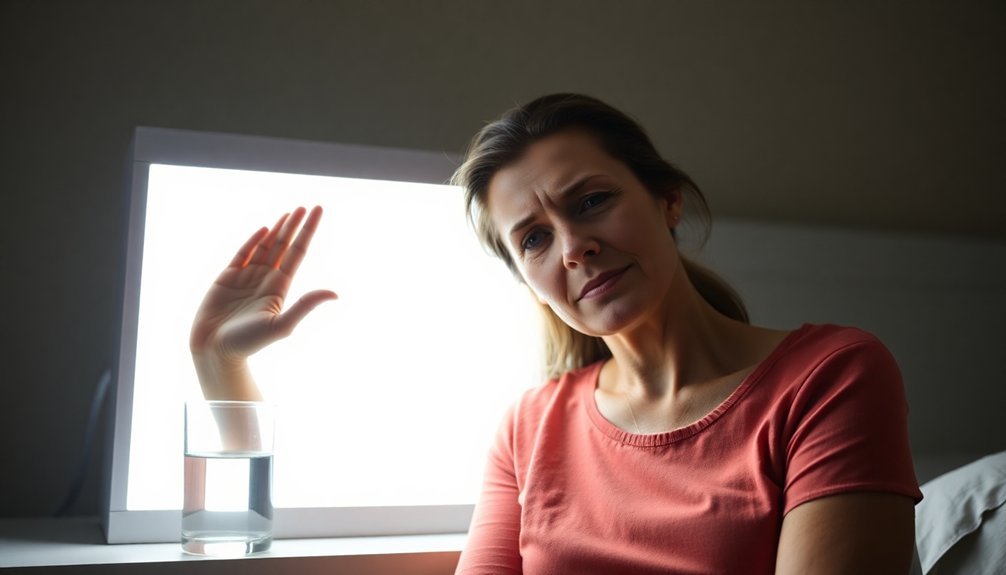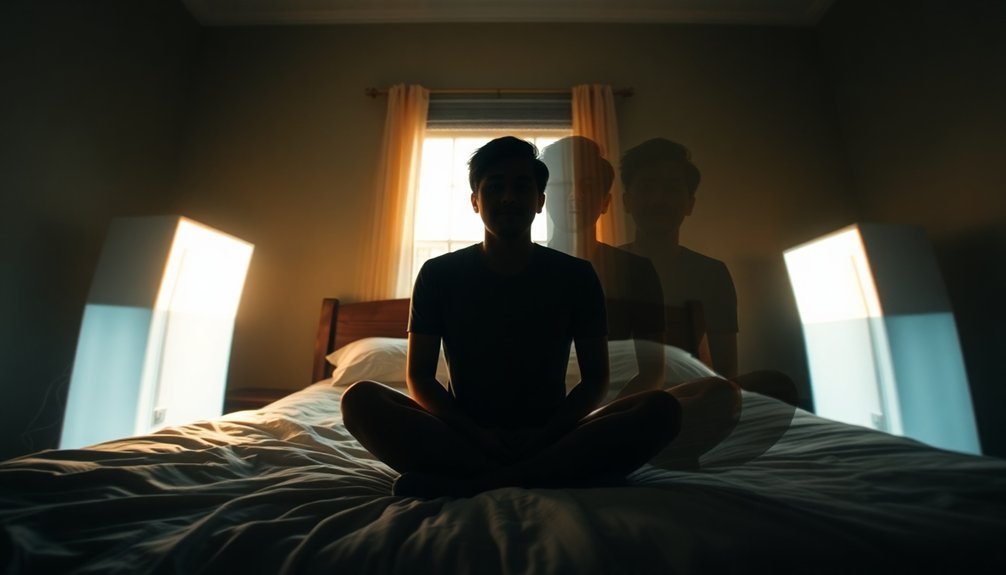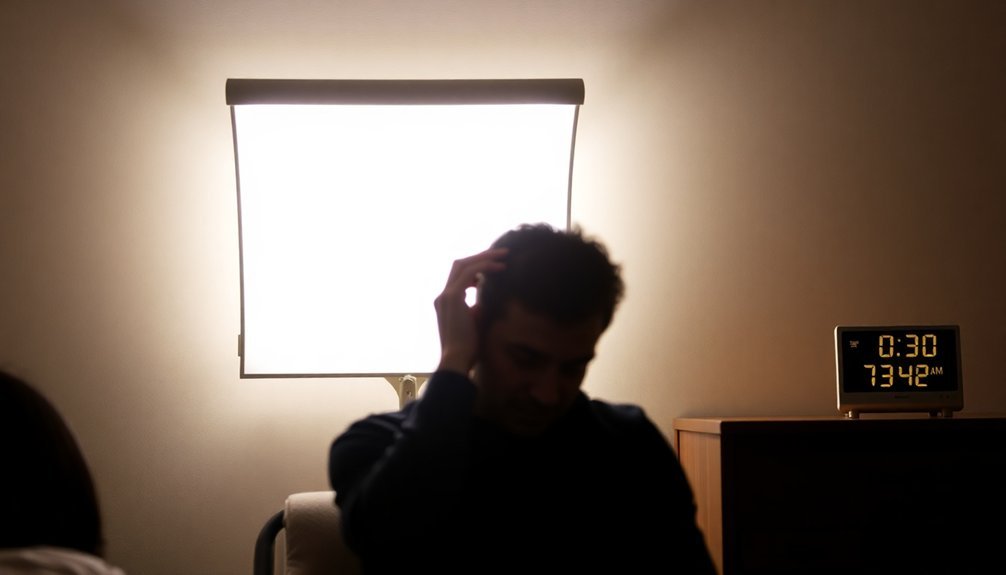You might feel dizzy during SAD light therapy because the bright light quickly changes your brain's chemistry and disrupts your internal balance systems. When you're exposed to intense therapeutic light (typically 10,000 lux), it affects your body's production of melatonin and serotonin while altering your circadian rhythm. Your Suprachiasmatic Nucleus (SCN) processes these sudden light signals, which can temporarily throw off your spatial orientation. While dizziness is usually mild and temporary, lasting only through the initial days of treatment, it's worth understanding how timing your sessions and adjusting light intensity can help minimize these effects.
Light Therapy Safety Facts

Three key safety aspects make light therapy a generally well-tolerated treatment for SAD. First, the side effects are typically mild and temporary, with most people experiencing only minor issues like headaches or vision problems that resolve within the first few days of treatment. Regular treatments spaced 10-20 minutes per session are recommended for results.
Studies using both 10,000-lux and 2,500-lux treatments have confirmed this favorable safety profile.
You'll need to take specific precautions to guarantee safe treatment. Always wear protective goggles to prevent eye damage, and if you're pregnant, you can feel reassured that limited research suggests light therapy is safe for both parent and fetus.
If you're using high-strength red light therapy, be extra cautious as it can cause blistering and redness.
You should know that certain populations require additional consideration. If you have darker skin, you may be more sensitive to visible light and face an increased risk of hyperpigmentation.
If you have bipolar disorder, you'll need careful monitoring as light therapy can trigger mania or hypomania.
The FDA has cleared many light therapy devices for safety, though this doesn't guarantee their effectiveness.
Understanding Dizziness During Treatment
When you experience dizziness during SAD therapy, it's important to understand that your inner ear's balance system can be affected by various factors, including light therapy and any medications you're taking.
The intensity of light therapy itself doesn't seem to directly cause dizziness, as research shows no clear correlation between light strength and vestibular symptoms. Light therapy exposure of 2,500 to 10,000 lux is typically recommended for treating SAD symptoms effectively.
Your healthcare provider should carefully evaluate any vertigo-like symptoms you develop during treatment, as they could stem from medication interactions or underlying balance disorders rather than the SAD therapy itself.
Inner Ear Balance Effects
Balance disruptions during SAD therapy often stem from complex interactions between your inner ear system and treatment methods. Your inner ear's vestibular system plays a vital role in maintaining balance by constantly sending information to your brain about your head's position and movement. Motion sickness symptoms can intensify these balance disturbances.
During SAD therapy, particularly light therapy, you may experience dizziness because the treatment can affect how your central nervous system processes balance information. Your body relies on a steady flow of sensory input from multiple sources – your ears, eyes, tissues, and nervous system – to maintain stability.
When therapy disrupts this delicate system, you'll likely experience disorientation or dizziness.
If you're experiencing these symptoms, your doctor might recommend vestibular rehabilitation therapy (VRT) alongside your SAD treatment. This specialized approach helps retrain your balance system and can substantially reduce dizziness.
You'll need to work closely with your healthcare provider to adjust your treatment plan, as they may need to modify medication dosages or light therapy intensity. Remember that while inner ear effects are common, they're manageable through individualized treatment approaches that consider your specific symptoms and responses to therapy.
#
Light Intensity Impact
Factors
The intensity of light therapy plays a direct role in how your body responds to SAD treatment, building upon the inner ear effects we've discussed.
When you're exposed to a 10,000 lux light box, which is the standard intensity for SAD therapy, your body can experience various reactions, including dizziness.
You'll find that the duration of your sessions markedly impacts how intense these effects might be. While the typical recommendation is 30-45 minutes of daily exposure, you may need to start with shorter sessions if you're experiencing dizziness.
Your body often needs time to adapt to this intense light exposure, and you shouldn't rush the process. Experiencing abnormal melatonin levels during treatment can contribute to feelings of dizziness.
If you're particularly sensitive to light or have pre-existing eye conditions, you'll need to be extra cautious with light intensity levels. It's essential to work with your healthcare provider to find the right balance, as they can help you adjust the intensity and duration based on your individual needs.
Remember that environmental factors, including your natural light exposure throughout the day, can affect how you respond to treatment. You might find that morning sessions are more effective and cause less dizziness than sessions at other times.
Medication-Related Vertigo Causes
Medication side effects can trigger unexpected bouts of dizziness during SAD treatment, particularly if you're taking antidepressants as part of your therapy plan.
When you start new medications that affect your central nervous system, you might experience balance disruptions and vertigo-like symptoms, especially during the initial few weeks of treatment.
If you're experiencing dizziness after starting SAD medications, it's vital to understand that this side effect occurs due to how these drugs interact with your nervous system. You'll want to monitor whether you're experiencing peripheral vertigo, which typically stems from inner ear disturbances, or central vertigo, which relates to brain function changes.
The symptoms might include spinning sensations, unstable vision, and difficulty maintaining balance.
Don't try to tough it out if you're experiencing severe dizziness. Contact your healthcare provider, as they may need to adjust your medication dosage or switch to a different type of antidepressant. They can also evaluate whether your dizziness stems from the medication itself or if there are other underlying factors that need addressing.
Managing these side effects early is vital for ensuring your SAD treatment's success.
Common Side Effects Explained

You'll notice physical symptoms like dizziness and nausea when starting SAD therapy, which often appear alongside common side effects like headaches and eyestrain.
Light therapy can trigger these reactions through its impact on your body's melatonin and serotonin levels, particularly during the first few days of treatment.
If you're combining light therapy with antidepressants or SSRIs, you might experience additional balance-related side effects as your body adjusts to the dual treatment approach.
Recognizing Physical Symptoms First
Physical symptoms of SAD therapy can emerge in distinct patterns, depending on whether you're using light therapy, medications, or vitamin supplements.
With light therapy, you might experience headaches and eyestrain early in your treatment, affecting up to 17% of patients. You may also feel "wired" or overstimulated, which happens to about 14% of people using light boxes.
If you're taking SSRIs or other antidepressants, you'll likely notice different symptoms. Watch for nausea, dizziness, and sleep disruptions, though these typically improve within 4-8 weeks as your body adjusts to the medication.
When using vitamin D supplements, you'll generally experience minimal side effects, but dizziness can occur in rare cases.
It's essential to recognize that your underlying SAD symptoms may include significant physical changes. You'll notice distinct patterns between winter and summer SAD: winter SAD often leads to overeating and weight gain, while summer SAD typically causes poor appetite and weight loss.
Your energy levels will fluctuate too – expect low energy in winter SAD and restlessness in summer SAD. Understanding these patterns helps distinguish treatment side effects from the condition's symptoms.
Understanding Light Therapy Effects
While recognizing physical symptoms helps track your progress, understanding light therapy's specific effects gives you a clearer picture of what to expect during treatment.
Headaches are the most common side effect, affecting about 20% of people, followed by eye or vision issues in roughly 18% of cases. You might also experience feelings of anxiety or being "wired" (14-2.9%), nausea (7.1%), or dizziness (4.3%).
The good news is that these side effects are typically mild and temporary. If you're experiencing headaches, they'll likely subside after your third day of treatment. Vision-related issues also decrease substantially, with fewer than 10% of people still affected by days 4 and 5.
It's worth noting that the intensity of the light doesn't seem to influence the frequency of side effects – people using 10,000-lux light therapy report similar experiences to those using dimmer lights.
Despite these temporary discomforts, light therapy remains highly effective, with over 78% of people showing notable improvements in their SAD symptoms. You can usually continue treatment without interruption, as these side effects rarely interfere with the therapy's progress.
Medication-Related Balance Changes
Experiencing dizziness during SAD treatment often stems from medication-related balance changes, particularly when starting antidepressants. When you begin treatment, your body needs time to adjust to the medication, which can temporarily affect your equilibrium and cause sensations of lightheadedness.
| Common Side Effect | What You Can Do |
|---|---|
| Morning Dizziness | Take medication with food |
| Vision Changes | Report to healthcare provider |
| Sleep Disturbances | Take medication earlier in day |
| Balance Issues | Rise slowly from sitting/lying |
| Headaches | Stay hydrated, track timing |
You'll likely notice that these symptoms are most pronounced during the first few weeks of treatment. While most side effects are mild and temporary, it's essential to monitor your body's response. If you're experiencing severe dizziness or other concerning symptoms, don't hesitate to contact your healthcare provider. They can adjust your dosage or switch to a different medication that might work better for you.
Remember that taking antidepressants with NSAIDs can increase certain risks, so always inform your doctor about any other medications you're using. Most importantly, never stop your medication abruptly, as this can lead to discontinuation syndrome and worsen your symptoms.
Managing Balance Issues With SAD
Managing balance issues while coping with Seasonal Affective Disorder requires a careful approach to treatment and lifestyle adjustments. You'll need to work closely with your healthcare provider to develop a treatment plan that minimizes dizziness and other balance-related side effects.
Your healthcare provider can help you monitor and adjust treatments that might cause dizziness, such as light therapy or antidepressants. If you're experiencing balance issues, you should immediately report these symptoms to confirm your treatment plan can be modified accordingly.
Key lifestyle modifications can help you manage balance issues effectively:
- Maintain a consistent sleep schedule to regulate your body's internal clock
- Exercise regularly to improve both mood and physical stability
- Follow a balanced diet and avoid heavy meals before bedtime
- Get natural sunlight exposure whenever possible
While dizziness isn't a direct symptom of SAD, it can occur as a side effect of certain treatments. You can minimize these effects by combining treatments under professional guidance and making gradual adjustments to your therapy routine.
If you're using multiple treatments, it's especially important to track any side effects and discuss them with your healthcare provider.
Circadian Rhythm and Equilibrium

Your body's equilibrium system relies heavily on circadian rhythms, which can be thrown off balance when you undergo SAD therapy treatments that alter your sleep-wake patterns.
These disruptions can affect your inner ear's timing mechanisms, leading to temporary dizziness as your balance centers adjust to the new light exposure schedules.
The hormonal shifts triggered by SAD therapy, particularly changes in melatonin and serotonin levels, can further impact your sense of balance until your body's internal clock adapts to the new rhythms.
Sleep-Wake Balance Disruption
The delicate balance between sleep and wakefulness plays a crucial role in SAD therapy's connection to dizziness. When you undergo treatment for Seasonal Affective Disorder, your circadian rhythm undergoes significant adjustments, particularly when you're exposed to light therapy.
This disruption can temporarily throw off your body's natural equilibrium system, which relies heavily on consistent sleep-wake patterns.
Your body's balance mechanisms become particularly vulnerable during this adjustment period, as they're closely tied to your internal clock. When light therapy alters your melatonin and serotonin levels, you might experience temporary dizziness while your system recalibrates.
- Your vestibular system becomes more sensitive during circadian adjustments
- Morning light therapy can trigger sudden changes in alertness, affecting balance
- Sleep pattern shifts can temporarily disrupt your spatial orientation
- The adjustment period typically lasts about two weeks
During SAD therapy, your central nervous system works overtime to process these changes, which can affect how it handles balance-related information. While the dizziness might feel concerning, it's often a temporary side effect of your body working to realign its natural rhythms.
Understanding this connection can help you better manage these symptoms while continuing your necessary treatment.
Inner Ear Timing Shifts
Beyond sleep-wake disruption, SAD therapy's effects reach deep into your inner ear's timing system. Your vestibular system, housed in the inner ear, doesn't just control balance – it's intricately connected to your body's circadian rhythm.
When you undergo bright light therapy for SAD, you're not only shifting your sleep patterns but also influencing this delicate vestibular-circadian relationship.
Your inner ear's timing system relies on consistent signals to maintain proper balance and spatial orientation. When bright light therapy alters your circadian rhythms, it can temporarily destabilize these vestibular inputs. This is particularly noticeable if you have any underlying vestibular conditions, as your balance system becomes more sensitive to these timing shifts.
The disruption occurs because your vestibular system helps synchronize internal and external circadian cues, and sudden changes in light exposure can throw off this coordination.
While the light-dark cycle remains the primary driver of your circadian rhythm, your vestibular system's response to these therapeutic changes can manifest as dizziness. If you're experiencing persistent dizziness during SAD therapy, you might need to adjust the timing or intensity of your light exposure.
Hormonal Clock Adjustments
Shifting circadian rhythms during SAD therapy triggers a cascade of hormonal adjustments that can leave you feeling dizzy and off-balance.
When you undergo light therapy, your body's internal clock begins to resynchronize with the solar day, affecting critical hormones like melatonin and adenosine that regulate your sleep-wake cycle.
Your body's Suprachiasmatic Nucleus (SCN) processes light signals from your optic nerves, initiating hormonal changes that can temporarily disturb your sense of equilibrium. While your vestibular system works to maintain balance, these rapid hormonal fluctuations can override its normal function, resulting in dizziness.
- Morning light therapy sessions are most effective but can cause initial jitteriness as your body adjusts to the new hormonal patterns
- Your melatonin levels will decrease during treatment, which might temporarily affect your balance
- The interaction between adenosine and melatonin levels can create brief periods of disorientation
- Stress during treatment can amplify these effects, as it influences both hormonal balance and your vestibular system
You can manage these symptoms by gradually increasing your light therapy duration and maintaining consistent treatment times to help your body adapt more smoothly to the hormonal adjustments.
## Light Intensity Impact
Light therapy's intensity plays a crucial role in both its effectiveness and side effects when treating SAD. The standard recommendation of 10,000-lux light exposure for 20-30 minutes daily can cause initial side effects like dizziness, nausea, and eye strain. However, these symptoms are typically mild and temporary compared to pharmaceutical treatments.
Different light wavelengths affect your treatment differently. Blue light (446-477 nm) has proven more potent for treating SAD than red light, while broad-spectrum white light works just as effectively with or without UV emission. Though researchers haven't determined the perfect wavelength combination, they've found that shorter wavelengths are more effective at shifting your circadian rhythm and suppressing melatonin.
If you're experiencing side effects, you can manage them by reducing light intensity or exposure time. Starting with lower intensities and gradually increasing them often helps minimize discomfort.
You'll get the best results by maintaining a consistent routine with your light therapy box, and starting treatment before your symptoms typically begin can prevent them from becoming severe. Remember, some people need continuous treatment to keep symptoms from returning.
Treatment Timing and Adjustments

When you begin SAD light therapy, timing substantially influences its effectiveness, though not necessarily its side effects like dizziness. While morning sessions are often recommended for their ability to advance your circadian rhythm, research hasn't shown that treatment timing directly affects dizziness occurrence.
You'll find that both morning and evening sessions can effectively improve SAD symptoms.
Your treatment schedule can be flexible, allowing you to adjust sessions based on your lifestyle and personal preferences. The key is maintaining consistency in your light therapy routine while working with your healthcare provider to find the best timing for your situation.
Here's what you should consider when planning your treatment schedule:
- Start therapy before your SAD symptoms typically begin to prevent or minimize depressive episodes
- Consider combining light therapy with vitamin D supplements, especially during winter months
- Adjust your treatment timing based on seasonal changes and your body's response
- Monitor your symptoms and discuss any concerns with your healthcare provider
Remember that while timing affects the therapy's impact on your circadian rhythm, you can achieve positive results with either morning or evening sessions as long as you maintain regular exposure and appropriate duration.
Inner Ear Sensitivity Concerns
Recent research into inner ear sensitivity has revealed an unexpected connection to SAD therapy, though not in the way many assume. While some patients report dizziness during treatment, there's actually no direct evidence linking SAD therapy to inner ear sensitivity causing this symptom.
You might be interested to know that researchers have been exploring innovative approaches to SAD treatment, including delivering light therapy through the ear canal. In fact, one clinical trial showed remarkable results, with 92% of patients achieving full remission using earphone-like devices that shine light directly into the ear canal.
However, this method targets light-sensitive proteins in the brain rather than affecting inner ear mechanics.
If you're experiencing dizziness during SAD therapy, it's important to understand that this isn't a commonly reported side effect of traditional light box treatment. Your symptoms might be related to other factors, as the tensor tympani muscle and Eustachian tube function can be affected by various stimuli.
While research continues into the relationship between inner ear sensitivity and SAD therapy, you should discuss any persistent dizziness with your healthcare provider to determine its true cause.
Melatonin Production and Stability

Understanding melatonin's role in SAD therapy reveals why dizziness often occurs during treatment. Your body's melatonin production naturally rises in the evening and drops in the morning, but if you have SAD, this pattern becomes disrupted. During winter months, you'll often produce more melatonin during daylight hours, which throws off your internal clock and can contribute to feelings of dizziness when therapy attempts to reset this pattern.
When you undergo SAD therapy, particularly light therapy, you're fundamentally forcing your body to quickly adjust its melatonin production. This rapid change can trigger temporary balance issues as your system adapts to the new rhythm.
Here's what happens during treatment:
- Light therapy suppresses your daytime melatonin production
- Your circadian rhythm begins shifting to match natural daylight patterns
- Your brain's suprachiasmatic nucleus (SCN) recalibrates its light sensitivity
- Your melatonin levels fluctuate as they stabilize to new patterns
The combination of these sudden changes in melatonin production can make you feel off-balance or dizzy. While your body works to establish a more stable melatonin cycle, these symptoms typically improve as your internal clock adjusts to the treatment schedule.
Prevention and Adaptation Strategies
Before starting SAD therapy, implementing effective prevention and adaptation strategies can substantially reduce your risk of experiencing dizziness.
Start by gradually introducing light therapy into your routine, beginning with shorter sessions and slowly increasing duration. You'll want to use your light box early in the morning to avoid disrupting your sleep patterns while maintaining a consistent schedule.
If you're prone to dizziness, wearing compression stockings can help prevent fainting episodes during therapy sessions. Practice gentle breathing exercises when you feel anxious or lightheaded, and remember that anxiety itself can trigger dizziness.
You'll find it helpful to monitor your body's responses and adjust accordingly.
Regular exercise, proper nutrition, and maintaining a stable sleep schedule will strengthen your body's resilience to side effects. If you're using a 10,000-lux light box, position it at the recommended distance and angle to minimize eye strain and headaches.
Don't hesitate to consult your healthcare provider about incorporating CBT or SSRIs into your treatment plan if needed. They can help you develop a personalized approach that addresses both your SAD symptoms and dizziness concerns.
Frequently Asked Questions
Can Wearing Tinted Glasses During SAD Therapy Reduce Dizziness Symptoms?
Yes, you'll find that wearing tinted glasses during SAD therapy can reduce dizziness by blocking blue light, minimizing fluorescent flicker, and decreasing visual overload. They're especially helpful if you're sensitive to bright lights.
Does Exercise Before or After Light Therapy Sessions Affect Dizziness?
You'll want to avoid exercising right before light therapy, as it can increase dizziness risk through dehydration and overexertion. It's better to wait a few hours between activities to minimize potential symptoms.
Are Certain Body Positions Better While Using Light Therapy?
You'll get the best results by sitting upright at eye level with your light therapy lamp, keeping it 16-24 inches from your face. Don't look directly at the light, but position yourself facing it.
How Do Seasonal Changes in Barometric Pressure Interact With SAD Therapy?
Based on available research, you won't need to worry about barometric pressure affecting your SAD therapy. There's no proven interaction between pressure changes and light therapy's effectiveness in treating seasonal affective disorder.
Can Specific Dietary Changes Help Prevent Dizziness During SAD Treatment?
You can reduce dizziness during SAD treatment by increasing magnesium and potassium intake, staying hydrated, maintaining stable blood sugar levels, consuming vitamin D-rich foods, and avoiding triggers like high-sodium snacks and alcohol.
In Summary
You'll find that dizziness during SAD light therapy typically resolves as your body adjusts to the treatment. If you're experiencing persistent vertigo, try reducing your exposure time, moving farther from the light, or using it earlier in the day. Don't hesitate to consult your healthcare provider to fine-tune your therapy schedule and confirm you're getting the most benefit while minimizing side effects.





Leave a Reply